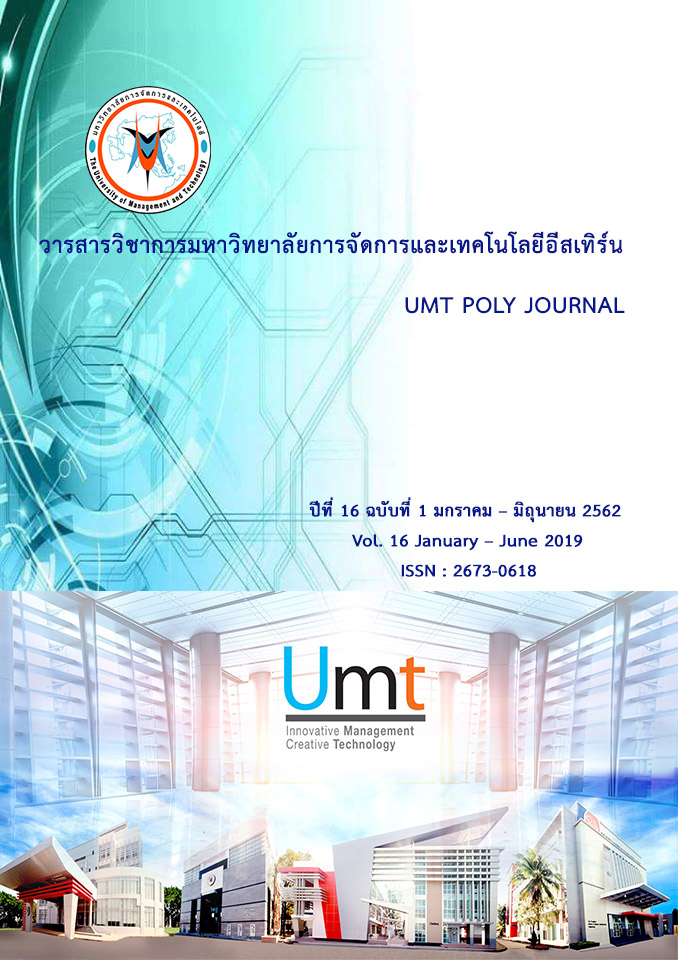การวิจัยความเสี่ยงในการผิดนัดชำระหนี้บัตรเครดิตในประเทศไทย
คำสำคัญ:
ทฤษฎีสัญญา, การผิดนัดชำระหนี้, ความสมเหตุสมผลแบบมีขอบเขต, บัตรเครดิตบทคัดย่อ
ความสัมพันธ์ทางเครดิตเป็นหนึ่งในงานวิจัยที่สำคัญที่สุดในอุตสาหกรรมการเงิน ในหลายปีที่ผ่านมา ความเสี่ยงในการผิดนัดชำระหนี้บัตรเครดิตในประเทศไทยได้เพิ่มมากขึ้นเรื่อย ๆ ความเสียหายในการผิดชำระหนี้เป็นสาเหตุให้เกิดการสูญเสียทรัพยากรทางสังคมและยังเป็นภัยคุกคามต่อความมั่นคงของระบบการเงิน บทความนี้จะยึดหลักทฤษฎีสัญญา แม้ว่าการวิเคราะห์ถดถอยพหุคูณโลจิสติกเกี่ยวกับปรากฏการณ์การผิดนัดชำระบัตรเครดิต ผู้เขียนได้ข้อสรุปโดยวิธีการของการวิจัยเชิงประจักษ์ ความสัมพันธ์เครดิตส่วนบุคคลเป็นรูปแบบที่เป็นรูปธรรมที่สำคัญของความสัมพันธ์ตามสัญญาทางสังคมในด้านการเงิน บทความนี้พยายามทำความเข้าใจเกี่ยวกับความสัมพันธ์เครดิตส่วนบุคคลระหว่างลูกหนี้กับเจ้าหนี้จากมุมมองของทฤษฎีสัญญาที่ไม่สมบูรณ์ สร้างจากแบบจำลองความเสี่ยงการผิดนัดชำระบัตรเครดิต จากการวิเคราะห์รูปแบบการผิดนัดชำระหนี้ ผู้เขียนพบว่าการผิดนัดชำระบัตรเครดิตไม่ได้ขึ้นอยู่กับประวัติข้อมูลเครดิตทางสังคม แต่สังคมควรจะสร้างกฎระเบียบแบบไดนามิกและกลไกจูงใจในด้านระบบกฎหมาย วิวัฒนาการของความสัมพันธ์ของสัญญาสินเชื่อและกลไกการโอนข้อมูลเครดิต นอกจากนี้ผลการวิจัยยังพบว่าความแตกต่างระหว่างเพศมีผลกระทบต่อการผิดนัดชำระ ซึ่งแสดงให้เห็นถึงการดำรงอยู่ของความสมเหตุสมผลแบบมีขอบเขตในพฤติกรรมทางเครดิตจากมุมมองของเพศ และยังยืนยันได้ว่าความถูกต้องของสมมติฐานความสมเหตุสมผลแบบมีขอบเขต อยู่ในทฤษฎีสัญญาที่ไม่สมบูรณ์ ซึ่งเป็นกรณีที่สมจริงสำหรับการวิจัยทฤษฎีสัญญาไม่สมบูรณ์
Downloads
เอกสารอ้างอิง
Andrew K.G.T., Yen S. T., Loke Y. J(2011). Credit Card Holders, Convenience Users and Revolvers: A Tobit Model with Binary Selection and Ordinal Treatment. Journal of Applied Economics, 14,225-255.
Canner, G. B., A.W. Cyrnak (1985). Recent Development in Credit Card
Crook , J. N ., Hami1ton, R. Thomas, L. e (1992). Credit Card Holders: Characteristics of Users and Non 一 Users. The Service Industries Journal, 12, 251-262 .
Chen Tingqiang, He Jianmin(2014). Research on Credit Risk Contagion Model Based on Complex Network. Chinese Journal of Management Science,11,1-10.
Chen W.M., Ma C .Q., Ma L (2009). Mining the Customer Credit Using Hybrid Support Vector Machine Technique. Expert Systems with Applications, 36, 7611—7616.
Chi Guotai, Xu Wen, Sun Xiufeng(2006). Research on Personal Credit Card Credit Risk Evaluation System and Model. Journal of Tongji University (Natural Science),4,557-563.
Fang Kuannan, Wu Jianbing, Zhu Jianping, Xie Banchang(2010). Credit Card Credit Risk Research under the Credit Information Asymmetry. Economic Research Journal, 97-107.
Fang Kuannan, Zhan Jianjun, Zhang Huiying(2014). Personal credit risk warning method based on Lasso-logistic model. The Journal of Quantitative & Technical Economics | J Quant Tech Econ,2,125-136.
Gao Xiaomei(2013). Chinese and American credit card market analysis. Technology & Market,11,229-232.
Ge Jun(2010). Credit Risk Research Based on Logistic Model. China credit card,24,26-32.
Hang Dechang, Wang Dahai(2007). Research on Demographic Characteristics, Social Environmental Factors and Credit Card Holdup of Chinese College Students. Shanghai Finance,11,79-83.
Hao Cheng, Cheng Gong(2008). Research on Term Structure of Default Probability Based on Structured Model. Journal of Systems Engineering,8,503-507.
He Zhenchang, Kong Li, Zhu Bing, Xiao Jin(2014). Research on the Factors Affecting Credit Card Cashing. Management review,10,38-45.
Heesun Noh Choi,SharonA.Devaney(1995). Determinants of Bank and Retail Credit Card Use. Consumer Interests Annual, 41, 148-154.
Huang ChunChun, Wu Yuanzhen(2014). Bounded Rationality and Credit Card Consumption: A General Discussion. Teaching and Research,5,69-76.
Huang Hui, Shen Hongbo(2010). Life cycle, consumer attitude and credit card usage frequency. Economic Research Journal,108-117.
Li Xian(2015). Discussion on Credit Risk Management Strategy of Credit Card Business. Times Finance,7,162.
Li Yongqiang, Bai Xuan, Kou Yan, Ma Liang(2008). Research on the Influencing Factors of Credit Card Opening Willingness and Frequency of Use. China industrial economics,2,104-112.
Jiang Minghua, Ren Xiaowei(2003). An Empirical Study of Money and Credit Attitudes Affecting Credit Card Overdraft. Journal of Financial Research,11,26-35.
Jiang Minghua, Ren Xiaowei(2004). An Empirical Study on the Relationship between Demographic Characteristics and Overdraft Behavior of Credit Card Holders. Journal of Financial Research,4,106-117.
Meidan, a., D. Davos (1994). Credit and Charge Cards Selection Criteria in Greece. International Journal of Bank Marketing, 12, 36-44.
Min I., J. Kim (2003).Modeling credit card borrowing: A comparison of Type I and Type II Tobit approaches. Southern Economic Journal,70, 128 - 143.
Ping Xinqiao, Yang Muyun(2009). An Empirical Study on the Influencing Factors of Consumer Credit Default. Finance and trade economics,7,32-38.
Pulina M(2011). Consumer Behavior in the Credit Card Market: A Banking Case Study. International Journal of Consumer Studies, 35, 86-94.
Ricky Yee-kwong Chan (1997). Demographic and Attitudinal Differences Between Active and Inactive Credit Cardholders-the Case of Hong Kong. International Journal of Bank Marketing , 15, 117—125.
Schreiner M (2004). Scoring Arrears at a Micro lender in Bolivia. Journal of Economics and Business, 6, 65—88.
Shen Hongbo, Huang Hui, Liao Li(2013). Research on Cardholder Overdraft Behavior in China's Credit Card Market. Statistical research,10,61-67.
Steidle, R. P (1994). Determinants of Bank and Retail Credit Card Revolvers: An application Using the Life-Cycle Income Hypothesis. Consumer Interests Annual, 40,164-171.
Xiao Junman, Ou Yuanyuan, Li Ying(2015). Research on the Influencing Factors of P2P Network Credit Risk in China-An Empirical Study Based on Ranking Selection Model. The Theory and Practice of Finance and Economics,193,2-6.
Xu Zhen(2014). Problems and Causes of Credit Card Risk Management. Modern economic information,1.282.
ดาวน์โหลด
เผยแพร่แล้ว
ฉบับ
ประเภทบทความ
สัญญาอนุญาต
ประกาศลิขสิทธิ์
เนื้อหาและข้อมูลในบทความที่ลงตีพิมพ์ในวารสารวิชาการมหาวิทยาลัยการจัดการและเทคโนโลยีอีสเทิร์น ถือเป็นข้อคิดเห็นและความรับผิดชอบของผู้เขียนบทความโดยตรง ซึ่งกองบรรณาธิการวารสารไม่จำเป็นต้องเห็นด้วยหรือร่วมรับผิดชอบใด ๆ
บทความ ข้อมูล เนื้อหาหรือรูปภาพ ฯลฯ ที่ได้รับการตีพิมพ์ในวารสารวิชาการมหาวิทยาลัยการจัดการและเทคโนโลยีอีสเทิร์น ถือเป็นลิขสิทธิ์ของวารสารวิชาการมหาวิทยาลัยการจัดการและเทคโนโลยีอีสเทิร์น หากบุคคลหรือหน่วยงานใดต้องการนำข้อมูลทั้งหมดหรือบางส่วนไปเผยแพร่ต่อหรือเพื่อกระทำการใด ๆ จะต้องได้รับอนุญาตเป็นลายลักษณ์อักษรจากวารสารวิชาการมหาวิทยาลัยการจัดการและเทคโนโลยีอีสเทิร์นก่อนเท่านั้น




